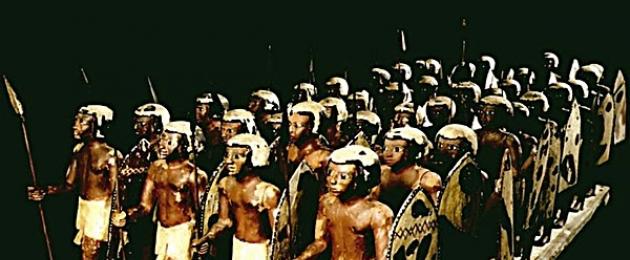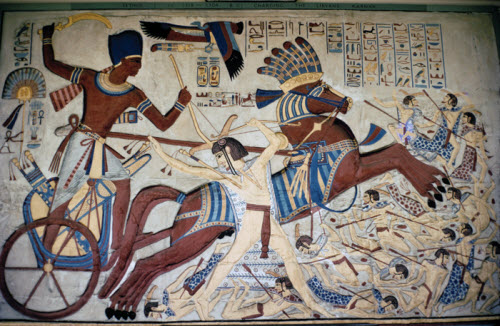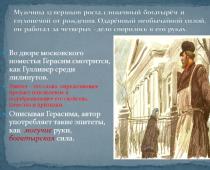The first weapons appeared at the dawn of civilization. The ancient hunter needed to protect himself from wild animals and get food for himself. After the emergence of states, wars began. The first major state was Ancient Egypt (from 3100 BC), whose history goes back about three thousand years. The Egyptians fought many enemies, created a well-organized army, and learned how to make different weapons.
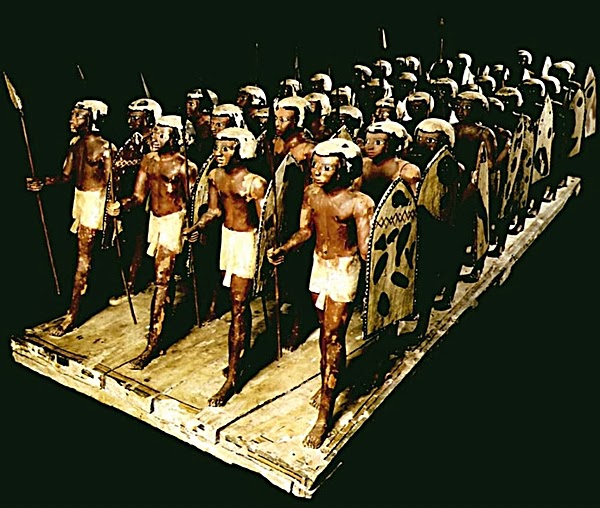
The backbone of the Egyptian army was infantry. Large military formations of 5 thousand people were divided into detachments of spearmen, archers, slingers, and charioteers. Recruitment into the army was mandatory (10 young men out of 100), in addition, volunteers were accepted. Strict discipline reigned in the army. The Egyptians used different combat formations and walking in step.

The main throwing weapons of the infantry were bows and arrows. Even the pharaohs used bows. Bows were simple, made of wood, and complex, reinforced with tendons, plates of bone and horn.
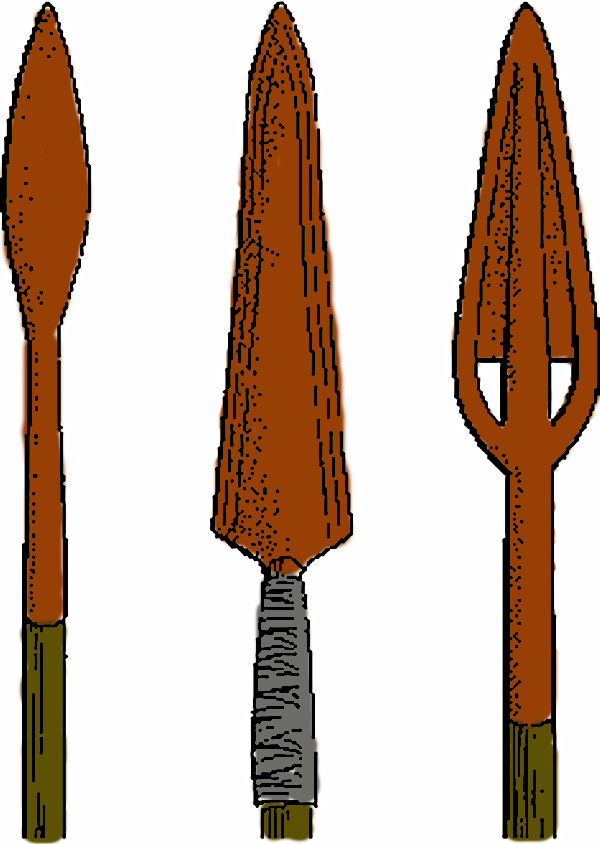
They threw darts and short spears by hand. In close combat, spears, axes, axes, daggers and crooked cutlasses were used - khopesh .

Khopesh - a curved cleaver for applying
slashing blows. Bronze blade, handle
bronze, wood or bone
In Ancient Egypt, all weapons were made only from bronze.
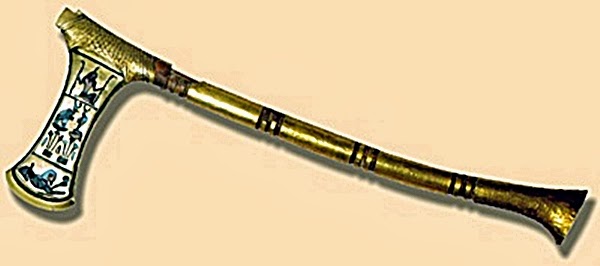
Ax - bronze warhead attached
to the wooden handle with plant fibers,
judging by the decorations it belonged to a noble military leader
The weapons of pharaohs and major military leaders were decorated with gold, precious stones and colored pastes.
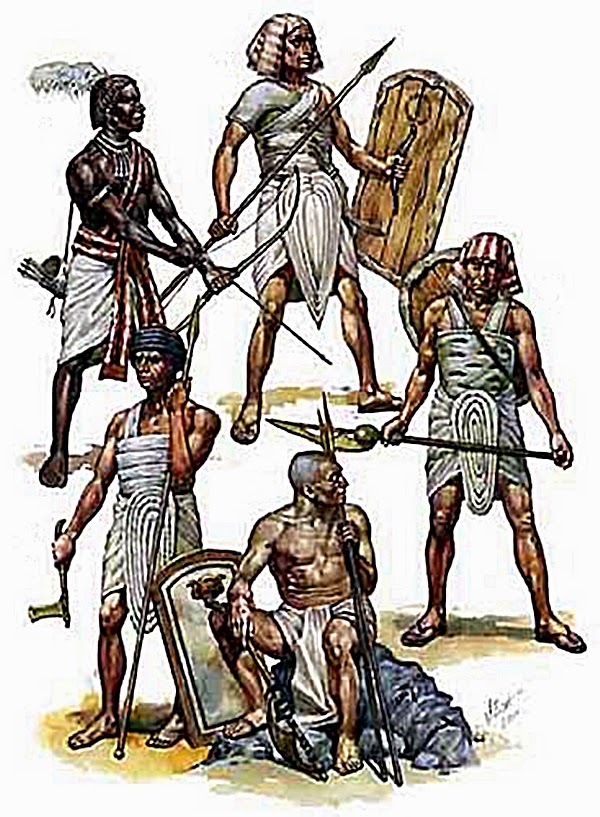
The main defensive weapons were rectangular wooden shields. They were covered with leather or skins. The body was protected by soft armor made of white fabric. This was convenient in hot climates. The armor consisted of strips of linen wrapped around the body. Quilted linen cuirasses and leather combat belts were also used. The head was covered with caps made of several layers of fabric. The rank and file fought naked to the waist, covering their lower bodies with a quilted cloth shield. A wig or a painted headdress was worn on the head. They fought barefoot; only rich people had leather sandals.
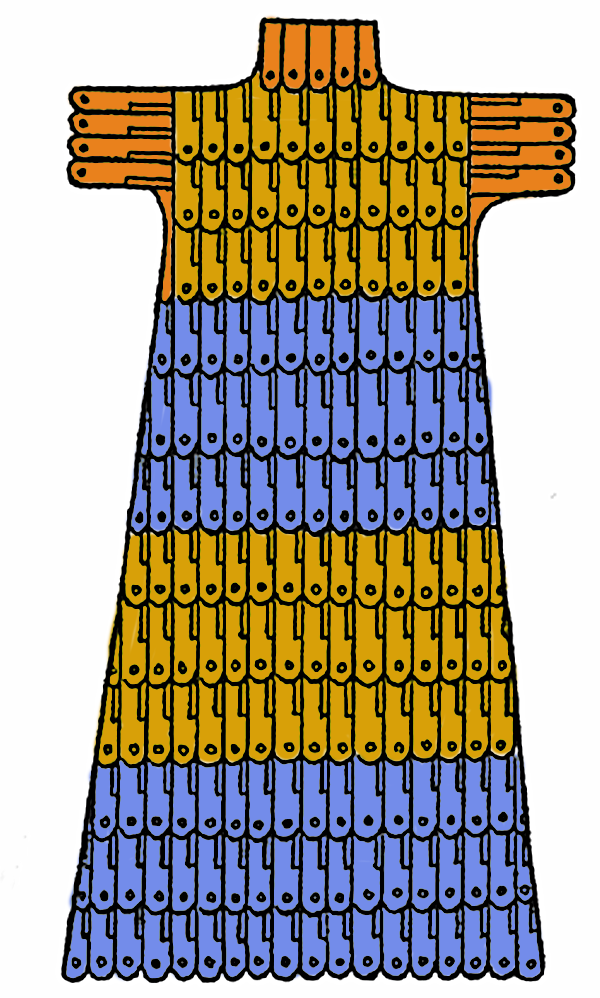
After numerous wars with tribes from Mesopotamia and Asia Minor, the Egyptians developed lamellar armor made of bronze plates. Only rich warriors - charioteers - could order such armor.
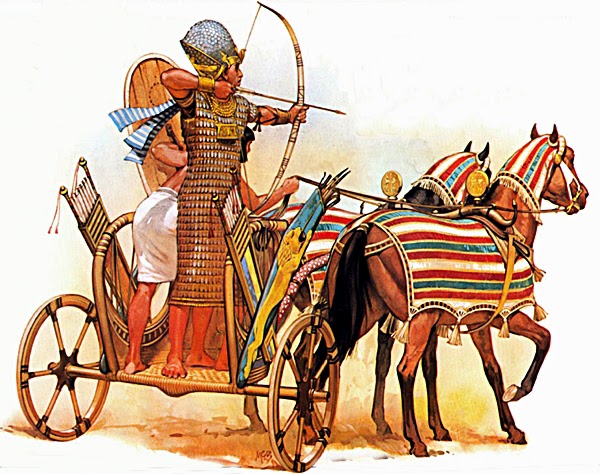
War chariot - it contained a charioteer and a shooter.
Archer in lamellar armor - owner of chariots and horses
As a branch of the army, chariots appeared after the conquest of Egypt by the Hyksos around 1700 BC. During the New Kingdom period after the expulsion of the Hyksos in the 1550s BC. Egypt's military art reached its peak. Egyptian chariots were two-wheeled, lightweight, the wooden frame was covered with leather, and the floor was wicker.
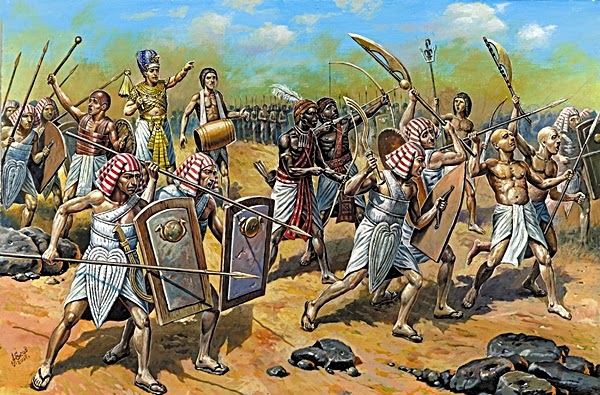
The battle began with infantry throwing arrows and darts, then chariots with archers went into the attack, and then warriors with melee weapons entered hand-to-hand combat. Mercenaries and prisoners from Nubia, Syria, and the islands of the Mediterranean Sea served in the Egyptian army.

Some of them came with their own weapons, for example, the Chardins from the island of Sardinia introduced the Egyptians to straight long swords and round shields. In the last centuries of the existence of the Egyptian kingdom, iron weapons appeared in it. In 30 BC. Ancient Egypt was conquered by the Romans and became a Roman province.
THE ARMY was organized in the form of military settlements located in the center of the country and in the most threatened areas; the main forces were in Lower Egypt, which was often attacked: there were fewer settlements in Upper Egypt, since the neighboring Nubian tribes could not be serious opponent Egyptians due to their fragmentation. Moreover, the conquered Nubian tribes were obliged to provide Egypt with a certain number of soldiers for internal “police” service. During large campaigns, the pharaohs strengthened their army at the expense of conquered neighboring tribes. These warriors cannot be considered mercenaries, since there is no evidence that they received any payment for their participation in the campaign. One can only assume their right to some share in the spoils of war.
Documents from the times of the Old Kingdom mention a “house of weapons” - a kind of military department, which was in charge of manufacturing weapons, building ships, supplying troops and constructing defensive structures. There is no data on the number of Egyptian troops during the Old Kingdom period. Regarding the fleet, there is only one mention of a detachment of 40 ships sent for the cedars.
The warriors of the Old Kingdom were armed with: a mace with a stone tip, a battle ax made of copper, a spear with a stone tip, and a battle dagger made of stone or copper. In an earlier period, the boomerang was widely used. The main weapons were a bow and a battle ax. As a defensive weapon, the warriors had a wooden shield covered with fur.
The army consisted of detachments. Sources that have reached us say that the soldiers were engaged in combat training, which was in charge of a special head of military training. Already during the period of the Old Kingdom, the Egyptians used formation in ranks. All the soldiers in the ranks had the same weapons.
 |
| Egyptian fortress in Semne. Reconstruction |
Fortresses of the Old Kingdom period had various shapes (circle, oval or rectangle). The fortress walls sometimes had round towers in the shape of a truncated cone with a platform at the top and a parapet. Thus, the fortress near Abydos was built in the shape of a rectangle; the length of its sides reached 125 and 68 m, the height of the walls was 7-11 m, the thickness in the upper part was 2 m. The fortress had one main and two additional entrances. The fortresses in Semne and Kumme were already complex defensive structures that had ledges, walls and a tower.
 |
|
Image on the walls of the Inti tomb at Deshasha |
When storming fortresses, the Egyptians used assault ladders with wooden disc wheels, which made them easier to install and move along the fortress wall. The breach in the fortress walls was made with large crowbars. This is how technology and methods of storming fortresses were born. The Egyptians were not natural sailors, and for a long time their voyages were limited to the Nile and the adjacent canals, which provided the most convenient means of communication among the mountains and deserts surrounding the country. The absence of forests, with the exception of acacia, a hard tree not very suitable for shipbuilding, forced for a long time to build (or, as they called it, “knit”) ships from long bundles of papyrus, a reed that grows in abundance in the country. Over time, the Egyptians had to use acacia in shipbuilding.
The Egyptians' ships were rowed, but they had sails. Each ship had a permanent crew with a chief at its head. The detachment of ships was headed by the chief of the fleet. The construction of ships was in charge of the so-called ship builder. “Two large fleets” were created: one in Upper, the other in Lower Egypt.
Sea ships carried out raids in the Mediterranean Sea.
Organization of the Egyptian army during the Middle Kingdom
The TERRITORY of Egypt during the Middle Kingdom was approximately 35 thousand square meters. km. Its population, according to ancient authors and modern estimates, was approximately 7 million people. Judging by the available data on recruitment in one of the nomes (one warrior per hundred men), the Egyptian army could consist of several tens of thousands of warriors. Several thousand warriors usually went on a campaign. The pharaoh had with him “retinue people” who made up his personal guard, and “companions of the ruler” - a group of noble warriors loyal to him, from which military leaders were appointed: “chief of the army”, “chief of recruits”, “military commander of Middle Egypt” and others superiors. 
The armament of Egyptian warriors during the Middle Kingdom period improved somewhat compared to the previous period, as metal processing became more advanced. Spears and arrows now had bronze tips. Impact weapons remained the same: a battle axe, a spear up to 2 m long, a mace and a dagger.

A spear for throwing, a boomerang, a sling for throwing stones, and a bow were used as throwing weapons. A reinforced bow appeared, which increased the range of the arrow and its accuracy.
The arrows had tips of various shapes and feathers; their length ranged from 55 to 100 cm. Common for ancient East arrows with a leaf-shaped tip, initially flint, and then copper and bronze, were less effective weapons than arrows with a faceted tip - bone or bronze, introduced by the Scythians in the second quarter of the 1st millennium. The fur-lined shield, half the height of a man, continued to be the only protective equipment.
 |
During the Middle Kingdom, the organization of the army was improved. The units now had a certain number of 6, 40, 60, 100, 400, 600 soldiers. The detachments numbered 2, 3, 10 thousand soldiers. Units of uniformly armed warriors appeared - spearmen and archers, who had a formation order for movement; They moved in a column of four rows along the front and ten ranks deep.
For their merits, warriors were promoted, received land, livestock, slaves, or were awarded “gold of praise” (like an order) and decorated military weapons.
From the west and east, access to Egypt was reliably protected by the Libyan and Arabian deserts.
To protect the southern border, three lines of fortresses were built in the area of the first and second cataracts of the Nile. The fortresses became more advanced: they now had battlements that covered the defending soldiers; protruding towers for shelling the approaches to the wall; a ditch that made it difficult to approach the wall. The fortress gates were protected by towers. Small exits were arranged for forays. Much attention was paid to supplying the fortress garrison with water; wells or hidden exits to the river were built.
Of the surviving remains of ancient Egyptian fortresses from that period, the most characteristic is the fortress at Mirgissa, built in the shape of a rectangle.
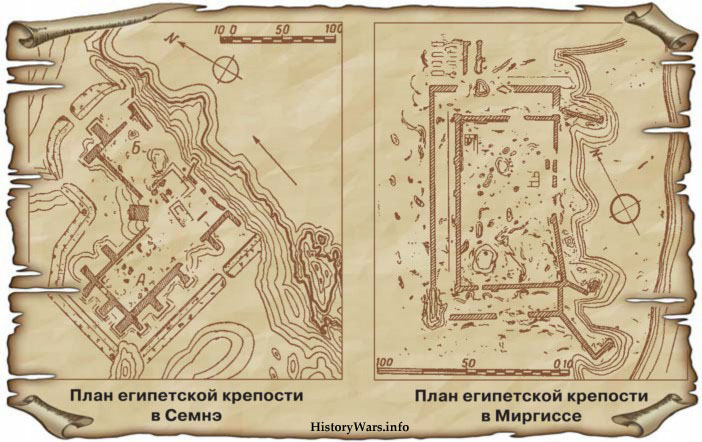
This fortress has an internal wall 10 m high with protruding towers located at a distance of 30 m from one another on the face opposite the river, and a ditch 8 m wide. An external wall was built 25 m from the internal wall, which surrounds the fortress on three sides; on the fourth side the cliff drops steeply towards the river. The outer wall is surrounded by a ditch 36 m wide. In addition, forward walls were built on rocky ledges, adjacent to the corners of the fortress and allowing flanking the approaches from the river. Other walls protected the main entrance to the fortress. The fortress in Mirgissa was already a complex defensive structure, which was based on the requirement of flanking the approaches. This was a step forward in the development of fortification - one of the branches of military art.
The most vulnerable place in the country's defense was the north - the lower reaches where the Nile flows into the Mediterranean Sea were open to conquerors. When the power of the pharaohs in the country was strong, it was here that the Egyptians kept the bulk of their fleet and land army. But during the uprisings against royal power the defense of the northern borders was sharply weakened, and Asian nomads could freely penetrate into Egypt.
The pharaohs and their commanders tried to fight quickly in order to return their troops home within a few months. Often the Egyptian army returned home after a three- or four-month campaign, having captured only one or two small fortresses. Major battles happened rarely - the commanders took care of the soldiers, whom they called “the flock of God.”
Organization of the Egyptian army during the New Kingdom
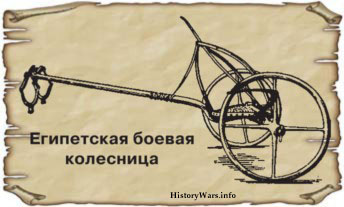
THE EGYPTIAN army during the New Kingdom was a military caste, divided by age or length of service into two groups, distinguished by the clothing they wore. The first group, according to Herodotus, numbered up to 160 thousand people, the second - up to 250 thousand. It must be assumed that these figures give the number of the entire military caste, including the elderly and children, and possibly women. So let's go to best case scenario Only tens of thousands of warriors could march.
Most of the warriors of the New Kingdom were armed with swords, and the bow played a significant role in battle. Protective weapons were improved: in addition to the shield, the warrior also had a helmet and a leather armor with attached bronze plates. An important part of the army were war chariots. The chariot was a wooden platform (1x0.5 m) on two wheels, to which a drawbar was tightly attached. The front part and sides of the chariot were covered with leather, which protected the legs of the combat crew, which consisted of a driver and one fighter, from arrows. Two horses were harnessed to the chariot.
The main force of the Egyptian army was the infantry, which, after the introduction of uniform weapons, consisted of archers, slingers, spearmen, and warriors with swords. The presence of equally armed infantry raised the question of the order of its formation.
If in more early time the Egyptians fought in deep, closed formations in the form of columns, then later, as a result of the improvement of weapons and the acquisition of combat experience, the depth of the formation decreased and the front lengthened - this was caused by the need to use a larger number of soldiers and weapons during simultaneous action. The battle formation of the Egyptian heavy infantry consisted of one closed line 10 or more ranks deep. War chariots were the moving force of the Egyptian battle formation. A closely closed formation of 10 or more ranks in depth (phalanx) was introduced for the first time not in Ancient Greece, and in the countries of the Ancient East.
Egyptian tactics boiled down mainly to a frontal attack.
Before the appearance of war chariots, the battle was started by foot soldiers - archers and dart throwers, then the opponents approached and decided the outcome in hand-to-hand combat. With the advent of chariots, the battle became more complicated - the chariots, for example under Ramses II, were built in one open line and located in front, on the flanks and behind the infantry. The chariot attack was aimed at disrupting the enemy ranks with the first blow. The success of the battle depended on the combination of the actions of war chariots and infantry.
War chariots, in addition, were a powerful means of pursuing the enemy. During the campaign, the Egyptian army was divided into several detachments that moved in columns. Reconnaissance was always sent ahead. When stopping, the Egyptians set up a fortified camp of shields. When storming cities, they used a formation called a “turtle” (a canopy of shields that covered the soldiers from above), a ram, a vine (a low canopy of vines covered with turf - to protect soldiers during siege work) and an assault ladder.
A special body was in charge of supplying the troops. Products were issued from warehouses according to certain standards. There were special workshops for the manufacture and repair of weapons.
During the New Kingdom, the Egyptians had a strong navy. The ships were equipped with sails and a large number of oars.
According to some reports, the bow of the ship was adapted for ramming an enemy ship.
Since the period of the Old Kingdom, Egypt has waged a huge number of wars of aggressive and defensive nature. For these purposes, a strong, united army of well-trained warriors was required.
The structure of the army of Ancient Egypt
IN Ancient kingdom There were no regular troops yet; they consisted of mercenaries. Such mercenary soldiers were recruited only during military campaigns, and in peacetime they went about their usual activities. They were paid well.
Already in the era of the Middle Kingdom, the army was quite highly organized. Egypt's troops were structured, recruitment into the army took place on a voluntary basis. There was a high military position - jati, who commanded the army and fleet and oversaw the recruitment of warriors. Then they appeared special units career officers, they carried out special military orders of the pharaohs. At the same time, a guard was formed to protect the king.
According to ancient Egyptian law, a person with income, in order to become an aristocrat, had to take 8 soldiers into his service. They had to be constantly prepared and engaged in military training, without being burdened with regular work. Notable rich people formed squad-companies, which were subordinate to colonels. During the era of the New Kingdom, there were many foreign mercenaries in the army, and later they formed the basis of the Egyptian army.
Armament of the army of Ancient Egypt
The main strength of the Egyptian army was infantry troops and chariot detachments, and from the period of the Middle Kingdom a battle fleet began to appear. Most often, warriors armed themselves with a copper ax, mace, bow, spear or copper dagger. For protection, they used a shield made of wood, which was covered with fur. In the Middle Kingdom, due to the development of metal processing, the spear, sword and arrowhead became bronze. At this time, detachments of archers and spearmen appear.
MILITARY CAMPAIGNS
PHARAOH
Ancient world
5th grade
Army of the Pharaohs
Army of the Pharaohs
Around 1500 B.C.
Egypt was ruled by a pharaoh
Thutmose. In those times
The Egyptian kingdom was
so much that no
strangers did not threaten
to him. Pharaohs
used strong
army for conquest
new lands and retention
under your own authority
conquered countries.
Army of the Pharaohs
Army of the Pharaohs
Most troops
consisted of infantry. Exodus
war largely depended on her
training and endurance. Kit
scribes were recruited into the army
by order of Pharaoh, the majority
the recruits were from
farmers. Experienced
commanders trained soldiers
march and run
in ranks, shoot them with bows,
wield a spear, hatchet and
with a dagger. Lazy
beaten mercilessly
sticks, wounds from beatings on
the head and body will not last long
were healing.
Army of the Pharaohs
Army of the Pharaohs
The infantry was divided by type of weapon
for archers - archers -
and spearmen. There was a bow
the main type of long-range
weapons. Arrows were often made
made of reeds with bronze
tips, they were worn in
special cases - quivers. In
battle time archers for
speed and convenience took out
several arrows at once and
kept them in right hand
between thumb and index finger
fingers.
Army of the Pharaohs
Army of the Pharaohs
The Egyptian spear consisted of a long strong shaft and
bronze tip. The infantrymen defended themselves with small
light shields convenient in hand-to-hand combat. Shields
consisted of wood and woven from strong reed
leather-covered base. Metal helmets in Egypt
were very rare. Usually warriors wore hats
made of leather or linen, often with stripes.
Army of the Pharaohs
Army of the Pharaohs
In ancient Egyptian painting, the artist beautifully
conveyed the rapid movement of a detachment of spearmen,
his training and unity. Everyone marches in step, warriors in
striped caps are armed with shields, spears,
hatchets and twisted swords.
Army of the Pharaohs
Army of the Pharaohs
At the head of the army was the supreme ruler of the country - the pharaoh.
In all important battles he personally commanded the army.
Flattering and obsequious nobles attributed everything to the pharaoh
military victories. “Oh, if it were not for His Majesty, may he live,
long live, may he be prosperous! We would never
defeated the enemy army."
Army of the Pharaohs
Army of the Pharaohs
In the middle
second
millennium before
AD Egyptians
become
use
combat
chariots,
harnessed
horses. This
allowed
create a big
chariot
army,
played
huge role in
Egyptian
army.
Army of the Pharaohs
Army of the Pharaohs
The chariot had two wheels
with knitting needles. On the axis between
reinforced with wheels
platform where two stood -
one drove the horses, and
the other shot with a bow and
threw short ones at opponents
spears - darts. Area
attached to a long stick -
a drawbar for which two horses
they were pulling a chariot. All
chariot, including wheels and
knitting needles, made from
durable wood. On the site
made covered with leather
sides to protect feet
drivers and shooter.
Conquests
Conquests
pharaohs
pharaohs
What country was it
What country was
conquered south of Egypt?
conquered south of Egypt?
Which country is west of
Which country to the west of
the Nile delta invaded
the Nile delta invaded
Pharaoh's troops?
Pharaoh's troops?
What kind of peninsula was it?
What kind of peninsula was
captured by Pharaoh's troops
captured by Pharaoh's troops
west of the delta?
west of the delta?
What countries are north of
Which countries north of
Sinai Peninsula
Sinai Peninsula
conquered the Egyptian troops?
conquered the Egyptian troops?
Find on the map in the textbook
On the map in the textbook, find
name of the river to which
name of the river to which
the possessions of the Egyptians reached
the possessions of the Egyptians reached
in the north?
in the north?
Conquests of the Pharaohs
Conquests of the Pharaohs
The largest conquests were made around 1500 BC.
Let's read the description of one of Thutmose's campaigns on the village. 46.
n. e. Pharaoh Thutmose.
n. e. Pharaoh Thutmose.
Consequences
Consequences
conquests
conquests
After each campaign, the troops returned with
prey to the capital of Egypt, which becomes
city of Thebes.
Consequences
Consequences
conquests
conquests
Egyptian warriors from conquered countries
drove crowds of prisoners. The winner had
the right to kill the vanquished. If he
spared the prisoner, he became
master of his life and death. Prisoners
could be turned into slaves, branded as
From top to bottom - Nubian,
Libyan, Asian
livestock and sell.
Consequences
Consequences
conquests
conquests
Some Egyptians war
enriched by: pharaohs
generously rewarded
military leaders and
charioteers.
Nobles
became even more
richer. Others
Egyptians long
wars brought to
impoverishment. Wars
ruined the main
population of the country -
its workers.
Consequences
Consequences
conquests
conquests
Pharaohs often did not
trusted Egyptian
to the warriors. For your
they are guards
preferred hired
army of foreigners.
Mercenaries who received
payment from the treasury,
seemed to the pharaoh
more reliable
support for chance
conspiracy of nobles or
disturbances of simple
Egyptians
Foreign Mercenary
Consolidation of what has been learned
Consolidation of what has been learned
material
material
Archers and
Archers and
1. By type of weapon, the infantry was divided into...
spearmen
spearmen
2. . What weapons did Egyptian warriors use?
Bow, spear, battle axes,
Bow, spear, battle axes,
daggers
daggers
3.3. What metal was used in production
weapons?
Bronze
Bronze
4. Which pharaoh made the largest conquests?
Thutmose
Thutmose
5. 5. What countries were conquered by the Egyptians?
Nubia, Libya, Sinai
Nubia, Libya, Sinai
peninsula, Syria, Palestine,
Phenicia, Syria
Phenicia, Syria
6. Who did Pharaoh recruit for his guard?
Mercenaries
Mercenaries
The luxury that the nobility allowed themselves seemed nothing in comparison with the pomp with which the royal couple surrounded themselves. Pharaoh tried to prove that he was truly the son of the Sun. He and his wife wear a special bandage, around which a golden ureus is wrapped, and the head of a terrible snake is located just above the monarch’s forehead.
Uraeus, whose bite leads to inevitable death, was considered a symbol of unlimited power, and therefore not only the pharaoh’s headband, but also his crown, belt and helmet were decorated with his image. In general, the attire of the royal couple differed from the clothing of other nobility only in the high cost of the material. Their clothes were made mostly of the finest linen.
By the way, the autobiography of the courtier Xinde, written by him 2000 years BC, has reached us, where he praises the extraordinary quality of the canvas given to him by the pharaoh. In addition to linen, various materials made from wool and paper were used.
The armament of the king-pharaoh consisted of a leather helmet, decorated with ureus and ostrich feathers, usually blue, with a yellow bandage. The armor fit tightly to the torso and was made from colored belts or padded canvas. The king fought only on a chariot.
A lot of money was spent on all kinds of decorations and jewelry. Even men wore elegant bracelets made of noble metal. And women put the same bracelets on their ankles, and put ring-shaped earrings in their ears.
The fingers were hung with rings, and every man was proud of some precious ring, on which they had worked a lot gemmaglyptics. Scarabs were especially common decorations. Scarab, the dung beetle, was considered a symbol of fertility and creativity because its eggs, enclosed in balls of earth, come to life under the influence of the sun's warmth.
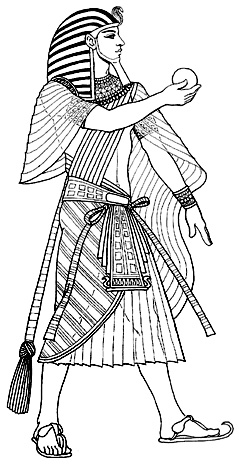
Based on this, such bugs were worn by everyone and were made in abundance from lapis lazuli and other precious stones. Subsequently, when hieroglyphs began to be carved on the flat side of these decorations, they acquired the character of amulets and were worn around the neck on a special cord.
As for the Assyrian and Egyptian warriors, the first ones were all tattooed. As Lucian says: “They all wear marks on their bodies in honor of the Syrian goddess.”
Their armament consisted of armored shirts, which either covered the entire body and arms, or only reached the waist. They were made of canvas or leather and covered with metal plates. There were also shells lined with pieces of leather of different colors.
The infantrymen wore a crossed belt over a leather jacket, fastened at the front with a metal plaque. With a short armor, they wore narrow trousers covered with metal plaques, tied under the knee with a belt, and high laced boots.
The helmets were round and sometimes decorated with hair combs. Headphones were often attached to helmets. Large shields were made of wood and wicker and pointed at the top. Hand shields - round, recessed or flat, metal, wicker and wood.
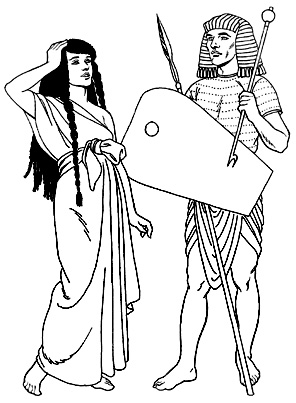
The weapons were bows, which were placed in cases during movement, spears, swords and daggers. The hilt had the shape of a ball, oval, pear, etc., the quivers were finished with metals. The infantry were armed with spears, slings and double axes.
In contrast to the heavy weapons of the Assyrians, the Egyptians were light.
Those fighting on chariots wore leather helmets with metal trim, armor similar to the royal one, as well as crocodile skin jackets, etc.
Infantrymen wore short, narrow sleeveless tunics or tight-fitting skirts with an apron-like extension at the front, trimmed with leather strips.
The weapons were light metal and wooden bows with quivers hanging over the shoulder, spears, a short sword with a long handle, a short straight sword, daggers, axes, and slings. There were shields different shapes, is not at all round; they were almost always straight at the bottom and rounded at the top.
- In contact with 0
- Google+ 0
- OK 0
- Facebook 0

